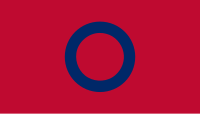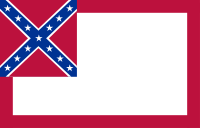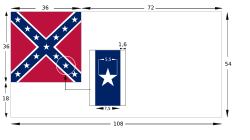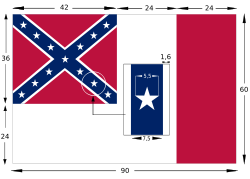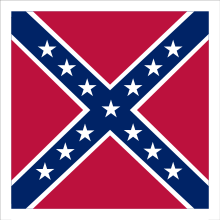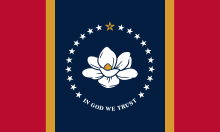Flag of the Confederate States of America



The Confederate States of America ( Confederate States of America , CSA) had successively six different national flags that their motives as "Stars and Bars" ( "Stars and Bars"), "Stainless Banner" ( "Flawless banner") and "Blood -Stained Banner ”(“ Bloodstained Banner ”). The four initial Stars and Bars flags were based in their motifs on the " Stars and Stripes " ("Stars and Stripes"), the flag of the United States.
The well-known "rebel flag" ( blazon : a white-framed blue cross covered with thirteen white stars on a red background ), also known as the "Southern flag " or "Confederate flag ", was never the official national flag of the Confederate States, but the war flag of the Army of Northern Virginia , thus the main Confederate army from 1861 under the command of General Robert E. Lee , but this was square. In its rectangular shape it corresponds to the war flag of the Army of Tennessee from 1864 or the jack of the Kriegsmarine from 1863. However, this war flag is also referred to as the "Confederate flag" in the American media, although this is only partially true.
National flags of the Confederate States
Provisional flags 1861
For the first 24 days of its existence, the Confederate States did not have an officially recognized national flag. When Jefferson Davis was sworn in as President of the Provisional Government on February 18, 1861 , the state flag of Alabama was flying over the government building in Montgomery . The soldiers in the Inauguration Parade were led by a company of infantry, which in turn displayed the Georgia state flag .
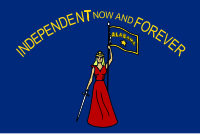
|

|

|
| Flag of Alabama 1861, front side | Flag of Alabama 1861, back side | Flag of Georgia 1861 |
|
|
|
|
Official flags from 1861 to 1865
The first national flags of the Confederate States, the so-called "Stars and Bars" ("Stars and Bars"), were made with different numbers of stars. Since there were no precise regulations and the number of members was constantly changing, different flags were sometimes displayed at the same time. Flags preserved after the Civil War showed versions with 8, 9, 10, 12, 14 and 15 stars in the corner.
The penultimate national flag was white with the war flag in the upper left corner and was called the "Stainless Banner" ("Immaculate Banner"). In order to avoid confusion with the completely white surrender flag, the Stainless banner was supplemented by a vertical red bar in 1865. This flag was then called "Blood-Stained Banner" because of the red bar.
National flags made at the Mobile , Alabama flag factory did not have a 13th star for reasons unknown.
Proposed national flags 1861
The Confederate States' Provisional Congress appointed South Carolina MP William Porcher Miles to chair the committee that would establish the state's flag and seal. Hundreds of proposals for the national flag have been submitted from all over the country. Even residents of states that were still part of the United States of America in March 1861 sent drawings. The unwritten deadline for the acceptance of the flag was March 4, 1861, as Abraham Lincoln was to be sworn in as President of the United States of America on this day . A separate national flag should affirm independence at this point in time.
As the deadline approached, there was still no agreement in sight. The proposals submitted could essentially be divided into two categories: those that had a certain resemblance to the flag of the United States, and those of very complex or complicated design. In particular, Chairman W. Porcher Miles rejected all proposals that imitated the flag of the United States too closely. Nevertheless, certain elements of this flag could not be completely neglected due to emotional feelings in the population. After the committee felt unable to make a final decision, four models were chosen to be put to Congress for vote.
On the morning of March 4, 1861, large models of the proposed flags were hung on the walls of the House of Representatives. The first of these models consisted of a blue diagonal cross bordered in white, which was on a red cloth. On the oblique cross there were seven five-pointed stars for the seven members of the confederation. This was a draft of Miles himself, but it was quickly rejected. One of the MPs compared the design to suspenders. Presumably, however, it was also decisive that the seven stars could not be brought into a symmetrical arrangement. The second flag that was rejected was somewhat similar to the flag of the United States, but the colors of the stripes were changed to blue and red. The third variant that was not accepted consisted of a completely different pattern: a blue circle on a red field, possibly intended to symbolize the solidarity of the southern states.
The flag, which finally received the blessing of the congress and went down in history as "Stars and Bars", was probably designed by the painter Nicola Marschall , an artist who came from St. Wendel in the Prussian Rhine province and has been in Marion since 1851 ( Alabama) was a resident. On the same day, a first copy of the new national flag was produced at short notice and hoisted over the Capitol building in Montgomery. Due to the necessary urgency, the Congress failed to pass a formal flag law, so that the "Stars and Bars" had in principle only an unofficial character for over two years.
Proposed national flag 1862
William Porcher Miles did not believe that the Stars and Bars flag was an appropriate state symbol. He did not share the emotions that much of the population still felt for the old US flag, and was very unhappy about the rejected proposals of 1861. However, as the war continued, the mood in the population changed and the Stars and Stripes flag of the USA became more and more a symbol of oppression and imperialist aggression. When the first elected Senate of the Confederate States met in 1862, a commission was immediately set up to think about a new national flag. On April 19, 1862, the commission submitted a proposal to the members of parliament that the new national flag should look like this:
“The flag consists of a red field on which a white cross is applied. In the center is a sun on a blue background with 13 rays. These correspond to the number of confederation members. "
In a further comment on this flag, the Commission stipulated that the blue background should be represented in the form of a shield. While the Senate was favorable to the proposal, an immediate debate on the resolution began in the House of Representatives. While some MPs, including W. Porcher Miles, were very pleased with the proposal and called for it to be introduced immediately, others opposed it. The MP Charles Conrad was of the opinion that a flag that had no “canton”, i.e. a small flag display on the upper corner on the mast side, could not be used at sea. Miles' objection that most seafaring nations did not fly such flags did not impress C. Conrad either. Because of this dissent, many MPs were of the opinion that the decision should be postponed. Many also believed that the new national flag should more closely resemble the newly introduced war flag of the Army of Virginia. Finally, a majority vote of 39-21 decided to postpone the decision.
Proposed national flags 1863
On April 22, 1863, the government commission made another attempt to change the national flag. The idea behind it was to do away with the similarities between the "Stars and Stripes" and the "Stars and Bars" by reversing the colors: Instead of a flag with a blue "canton" and red-white-red stripes, this should be an essentially red Replace canton ”with white-blue-white stripes. The war flag of the Army of Virginia was to become an important part of the Obereck.
While the Senate of the Confederate States approved the flag without any major debate, there were again heated arguments in the House of Representatives. A further change was required there in order to exclude any resemblance to the US flag. On May 1, 1863, the debate was opened and various suggestions for a modification were made. One of these proposals wanted to get rid of the stripes entirely and instead put a red border around a white field. A Mississippi MP even suggested removing the stars from the flag altogether in order to "separate the character of the southern states even more from that of the northern states." However, this was quickly rejected.
The MP William Graham Swan from Tennessee suggested, however, that the war flag of the Army of Virginia in a rectangular shape as the national flag. This flag corresponded to the draft submitted by William Porcher Miles in 1861 with seven stars at the time, but which had been rejected. However, after the flag had been “consecrated” by the shed blood of its own army in the past two years, a renewed attempt should be made to introduce it as the national flag. In the end, it was William Porcher Miles again who took the initiative and proposed a compromise. After that, one should use the flag of war on a "completely pure (English. Stainless ) field". Neither a blue stripe nor the "monstrosity" of a border should disturb the white field. Although one MP called for the resolution to be postponed again, it was ultimately decided to accept this proposal. That same day the Senate gave its approval, and that afternoon President Davis signed the law creating a new national flag, henceforth known as the "Stainless Banner".
The stainless banner
The so called “Stainless Banner” (translated: “Immaculate banner”) because of its pure white field should also represent a symbol for the purity of the motivation of the southern states. The new national flag was first used after the death of General Thomas J. Jackson . On May 2, 1863, Jackson was seriously wounded by his own troop fire at the Battle of Chancellorsville . On May 10, 1863, he died of severe pneumonia - not having recovered from his injury. At the direction of President Davis, his coffin was covered with the first newly manufactured national flag. This first stainless banner is still in the Confederation Museum in Richmond, Virginia and was often referred to as the "Jackson flag" because of its special use. This special identification of Thomas J. Jackson with the Stainless banner was also expressed later when issuing banknotes. In 1864 and 1865, dollar bills bearing the portrait of Jackson were issued along with a depiction of the national flag.
In contrast to the Stars and Bars flag, very precise specifications of all sizes were laid down in the legal text on the Stainless Banner. During the war, however, no particular emphasis was placed on maintaining all dimensions during manufacture. Neither the length of the flag nor the size of the stars was taken into account with great care, as shown by specimens that have survived after the war.
The stainless banner as a troop flag of the western armies
The second national flag of the Confederate States of America found only very limited use west of the Appalachians . However, there were two notable exceptions:
In November 1863, an officer from General Randall L. Gibson's Brigade of the Tennessee Confederate Army was assigned to travel to Mobile , Alabama, to obtain new flags. His instructions included that he should procure “new confederation flags” bearing “testimonies of honor” from past battles and the symbol of the “crossed cannon barrels”, which indicated the capture of enemy artillery. The lieutenant was successful and returned with a flag for each regiment and one for the 5th Washington Artillery Company. The flags were made of cotton and, like all copies made in Mobile, only had twelve white stars. In the white field, they were adorned, as requested, with information about battles, uses of the unit and the crossed cannon barrels.
After the Battle of Bakers's Creek in May 1863, Major General Loring's division escaped the siege of Vicksburg. During their winter quarters in 1863/1864 regimental tailors were probably commissioned to produce new flags. The flags produced in this way were variants of the Stainless banner and of quite different sizes. A striking difference to the standard model was that the red corner field contained a blue cross that had no white border. This also often ended well before the edge of the flag. Most of the time, the centrally placed star was shown significantly larger than the other stars. If fringe decoration material was available, this was usually attached to the three outer sides. These fringes were - depending on the supply - very differently colored and could be white, yellow, red or dark blue. None of these flags were provided with additional identifiers such as unit abbreviations.
Third national flag
While the Flag Act of 1863 solved the problem of a clear national identity by completely vexillological delimitation from the United States, the new flag created other difficulties. During the flag debate in 1863, MP Miles pointed out that it could not be confused with the surrender flag , as the stainless banner was modeled on the old Bourbon flag. In practice, however, it turned out that there was hardly any difference to the surrender flag, especially when there was no wind on ships. For this reason, people soon switched to shortening the white field in order to create a more concise flag. On December 13, 1864, Senator Thomas Jenkins Semmes of Louisiana submitted a bill to change the national flag again. In particular, he drew attention to objections from naval officers and suggested shortening the flag overall and adding a red, vertical stripe at the flying end. However, other members of the Senate asked for the opinion of army officers as well, and so the proposal was first referred to a military committee. After the time-consuming approval of all other institutions, President Davis signed the bill on March 4, 1865, and the Confederate States of America adopted their third and final national flag. As with the Stainless banner, there were exact specifications for the design of the flag. As the end of the war was imminent, there was little production of these flags. In contrast to the other national flag variants, only a few copies survived after the war. Due to time constraints, it was mostly decided not to produce flags according to legal requirements; rather, the stainless banner was usually shortened and a red stripe was sewn on. The war flag in the corner remained in a square shape, which actually did not correspond to the guidelines.
De facto use of the third national flag
The few remaining flags were made in the Richmond , Virginia flag factory (Richmond Clothing Depot). They were characterized by the fact that the war flag remained square in the corner. In addition, the white border of the blue diagonal cross was continued over the four corners.
Last use of the national flag
The last military unit to surrender to the Northern troops was that of General Stand Watie on June 23, 1865, which operated in the western Indian territories. A few weeks earlier, the major southern centers were under the control of United States troops and the Confederation national flag ceased to exist. The only exception was the CSS Shenandoah warship , which was tasked in the North Pacific with destroying enemy merchant ships. It was not until August 2, 1865, that ship's captain Waddell learned that the Confederate government no longer existed. Determined not to surrender to the US armed forces, he set course for Great Britain. On November 6, 1865, the ship arrived in Liverpool , where the national flag of the Confederation was lowered for the very last time.
The Confederate War Flag
Main article: War flags of the Confederate States of America
When the Confederate States of America formed their first Provisional Government in February 1861, one of their first tasks was to create a new national flag. From numerous proposals, the so-called Stars and Bars flag was finally adopted by the Congress on March 4, 1861.
Many military units - both regimental and company strength - immediately used this flag as a war flag. The first major battles of the war were fought under the Stars and Bars flag.
Many units of the Confederate Army also used their own special company flags. Since the battlefields were mostly heavily “fogged” by the gunpowder smoke, it was often not easy to distinguish between friend and foe. In some cases, the Stars and Bars flag was so similar to the Stars and Stripes flag of the Northern armies that it fired on its own units. This “friendly fire” often resulted in tragic deaths. So Southern staff officers began to think about a flag of war that would be completely different from that of the Union Army. In addition, the aim was to equip all units with the same flag as possible. The most famous was created in Virginia in September 1861 .
Under the leadership of General PGT Beauregard , an agreement was reached on a square red flag with a dark blue St. Andrews cross on which twelve white stars were placed. For heraldic reasons, the cross was framed in white. Production was planned in three sizes: 48 inches on a side for the infantry, 36 inches for the artillery, and 30 inches for the cavalry. In the course of the war, however, these guidelines were not always followed. Preserved post-war flags even showed that no 36-inch flags had apparently been made.
From November 1861 on, the first copies of the new war flag were delivered to units in Centerville .
War flags with thirteen stars were first produced in May 1862, although Kentucky was the thirteenth state to join the Confederation in December 1861 (by the so-called Russellville government, which, however, only represented a minority in the state).
The first national flag "Stars and Bars" retained its meaning as a flag in the field until the end of the war and was never completely replaced by the new version.
Flags of the Navy
- National flag at sea

The sovereign flag ("ensign") at sea corresponded in everything to the general national flag that was used in the corresponding period. On May 26, 1863, however, a change in the flag proportions was ordered: From this point on, the stainless banner at sea had a size ratio of 2: 3, in contrast to the national flag on land with a ratio of 1: 2.
- The jack
The Gösch of the Kriegsmarine - also known as the Southern Cross - is a rectangular version of the war flag. Another difference is the significantly lighter shade of navy blue of the St. Andrew's cross .
A similar version of this flag was originally planned to be the Confederation's first national flag. However, since the government commission felt that the cross was too reminiscent of suspenders, the proposal was rejected. The flag was not introduced until May 26, 1863 and was used until the end of the war. Previously (since March 4, 1861) the Gösch consisted of a blue flag on which white stars - in the number of confederation members - were arranged in a circle.
In addition to the Navy, the Army of Tennessee used a flag of war from 1864 that was very similar to the jack.
Nowadays the model is the generally recognized symbol of the "South", where it is called the "Rebel" or " Dixie " flag. It is also incorrectly referred to as the "Confederate Flag".
- The customs flag
The so-called Confederate States Revenue Service was a customs authority at sea that had the task of defending the coasts against smugglers ( water tariff ). One of the privileges of this authority was the right to fly its own flag. When choosing the new flag one kept z. Partly to the version of the northern states, which had vertical color bars. The overall impression was a flag that was very reminiscent of the French tricolor . The flag was introduced on April 10, 1861.
Use of confederation flags after the Civil War
In the first years after the end of the war, the use of all flags of the former Confederate States was banned. However, after the end of the so-called "Reconstruction", ie the reintegration of the former southern states into the United States, the use of all symbols was again freely used.
Mississippi
In 1894, the state of Mississippi decided to adopt a state flag that included the former Confederation's flag of war. Due to an omission, the flag was not officially confirmed in new legal texts of 1906. Until the bug was discovered in 1993, it was strictly an unofficial symbol of the state, until the incumbent governor of Mississippi officially enacted the state flag in 2000. It was not until a final referendum on April 17, 2001, in a controversial discussion, that the decision was made to keep the existing flag, including the Confederation's war flag. In June 2020, it was decided to abolish the previous flag and the draft of a new one was announced, on which the residents of Mississippi will vote on November 3, 2020 at the same time as the presidential election.
Georgia
Another state that is heavily based on the flags of the southern states in terms of symbolism is Georgia. In 1956, the Confederation's war flag was also incorporated into the new state flag. In the course of the next few years, this led in part to fierce controversy among the Afro-American population, who rejected a connection with the southern states. The dispute culminated in a redesign of the flag in 2001, in which the confederate flags were represented as "some of several" in a historical context. Due to persistent differences of opinion and a change in the political currents, the state flag was changed again in 2003, by now orienting itself strongly on the first national flag of the confederation "Stars and Bars".
tradition
The first group of traditionalists see the Confederate symbols (flag and monuments) as a respectful reminder of the history, traditions and culture of the US South. Removing them would be like denying the best qualities of southern life: an almost mystical belief in agrarianism , a passionate love of freedom, distrust of relentless, centralized authority, and a firm appreciation for home and family. For them it is a front of culture war . It's a cultural element for the classic southerner. It is a symbol of resistance to perceived northern political dominance.
A second group of traditionalists identify with the racist Confederate beliefs, white supremacy, and strong religious beliefs. A compromise is inconceivable for them. The war flag is used by the Ku Klux Klan , based on a faction that used it in ceremonies from 1943. Young supporters of the Dixiecrats , for whose establishment planned measures against racial segregation were decisive, used the symbols in the presidential election campaign in 1948. This use marks the formal association of the flag with modern politics. Some southern legislatures used Confederate symbols in the 1950s and 1960s as a symbol of opposition to court-ordered integration of blacks, who were thereby further charged with racist symbolism. The war flag and other symbols of the Confederation are also used by the American Nazi Party , Nazi skins and separatist movements such as the Aryan Nations (although the latter also use the US flag and the Christian flag ). Some schools and universities have banned the flag as a racist symbol. On the occasion, it was even considered a symbol of freedom of expression .
Criticism of its use as a racist symbol
The question of whether the Confederation's flag should be hoisted publicly or officially at all has regularly led to sometimes violent disputes in US politics and the media, especially during election times.
The Republican Fred Thompson took up the topic in his election campaign for the nomination for the US presidential election in November 2007 and pointed out that for many US Americans the flag is a "symbol of racism" and is therefore an official use reject at the state level. Thompson's competitor Mike Huckabee took a contrary position in a campaign speech on the occasion of the Primaries in South Carolina in January 2008. With reference to the states' rights , which have always been vehemently demanded in the political tradition of this state , he sharply attacked “outsiders” who came to South Carolina and criticized the use of the flag. Columnist Christopher Hitchens described Huckabee's statements as "clearly demagogic and racist".
Discussion of the use of the rebel flag flared up again after the attack in Charleston in which 21-year-old Dylann Storm Roof shot and killed nine black Americans on June 17, 2015 at the Emanuel African Methodist Episcopal Church in Charleston , South Carolina The defendant's Facebook page showed him burning the American national flag and then holding up the rebel flag. In addition, the defendant had sewn the flags of the two apartheid states of South Africa and Rhodesia on his jacket . Finally, on July 10, 2015, the flag was lowered forever in front of the South Carolina Parliament after both the state Senate and the House of Representatives voted in favor.
In the state of Mississippi , the last US state to use the flag as part of the state flag, Governor Phil Bryant and Lieutenant Governor Tate Reeves rejected requests to change the state flag in the summer of 2015 . While both state senators, Roger Wicker and Thad Cochran , had previously said the flag should be changed, Bryant announced that if a change were considered, it would be up to the voters to decide. The new flag "In God We Trust" is to be designed by mid-September 2020 and presented to the electorate for voting on November 3, 2020.
literature
- Devereaux D. Cannon, Jr .: The Flags of the Confederacy. St. Lukes Press, Memphis 1988, ISBN 0-918518-62-8 .
- Robert E. Bonner: Colors and Blood. Flag Passions of the Confederate South. Princeton University Press, Princeton 2002, ISBN 0-691-09158-7 .
- Philip RN Katcher: Confederate Flags of the Civil War . Heinemann / Raintree, Chicago 2003, ISBN 1-4109-0122-X .
Web links
- www.flaggenlexikon.de
- The CSA flags in the Flags of the World ( Engl. )
- Confederate Flags: Son of the South
Individual evidence
- ↑ a b James Michael Martinez, William Donald Richardson, Ron McNinch-Su: Confederate symbols in the contemporary South , University Press of Florida, 2000, ISBN 0-8130-1758-0 , pp. 6–7, 17, 109
- ↑ AP: Student's Confederate Flag Suit Thrown Out , CBS News, Aug. 12, 2009
- ↑ Michael Cooper: Confederate Flag Takes Center Stage Once Again . In: New York Times, January 18, 2008.
- ↑ Christopher Hitchens: Huck's Free Pass: Why are the media ignoring Mike Huckabee's remarks about the Confederate flag? . In: Slate , January 21, 2008.
- ^ Controversy over the southern flag: "Proud of one's own hatred". Spiegel Online, June 21, 2015, accessed June 21, 2015 .
- ↑ Abby Phillip: Church killings ignite furor anew over SC Capitol's Confederate flag. The Washington Post, June 20, 2015, accessed June 21, 2015 .
- ↑ South Carolina catches up with the southern flag forever. www.zeit.de, July 10, 2015
- ^ Neely Tucker, "In Mississippi, defenders of state's Confederate-themed flag dig in" Washington Post, August 18, 2015









